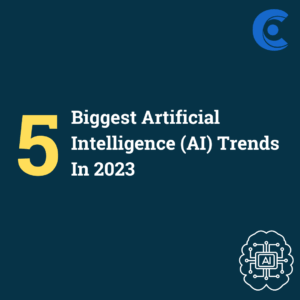The 5 Biggest Artificial Intelligence (AI) Trends In 2023

1. The Ongoing Democratization of AI
In 2023, AI will be accessible to everyone, thanks to an ever-growing number of apps that put its functionality at the fingertips of any user, regardless of technical skill. No-code and low-code platforms like SwayAI and Akkio allow anyone to create and deploy AI-powered solutions, overcoming the challenges posed by the AI skills gap. The democratization of AI will empower anyone to become an “armchair” data scientist or engineer, making its power and utility more attainable for all.
2. Generative AI
Generative AI algorithms, like GPT-3 and DALL-E, are being used to mimic creativity. They take existing data and generate new content that has never existed in the real world. This technology is becoming more mainstream, as seen in deepfaked videos and the Metaphysic act on America’s Got Talent. In 2023, we can expect increased use of AI-generated synthetic data, removing the need to film or record speech and providing businesses with a wide range of applications.
3. Ethical and Explainable AI
Ethical, transparent AI is essential for public trust. Personal data is needed for AI to learn, but data will only be shared with confidence. In 2023, efforts to overcome AI’s “black box” problem and reduce bias and unfairness in automated decision-making will rise. The importance of AI ethics will grow to eliminate discrimination and prejudice in crucial decisions.
4. Augmented Working
In 2023, intelligent machines and robots will be integrated into the workplace to enhance job efficiency. Augmented Working can include smart handsets for data access, AR headsets for digital information, real-time dashboards for management, and AI virtual assistants for quick answers and efficient methods. Working with these intelligent machines will become a crucial work skill, reducing the risk of job redundancy.
5. Sustainable AI
In 2023, firms will aim to cut their carbon footprint and environmental impact. AI algorithms consume vast power and resources, resulting in significant carbon emissions. Nevertheless, AI can help companies become energy-efficient by detecting waste and inefficiencies. The push towards sustainable AI involves using green and renewable energy sources. AI can also tackle environmental issues like deforestation and illegal fishing using computer vision and satellite imagery. In 2023, there will be a continued effort to use AI to solve environmental problems, not just for corporate profits.
